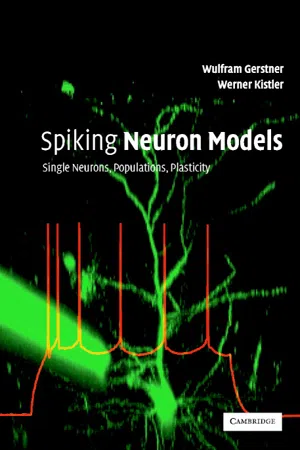
Spiking Neuron Models
Single Neurons, Populations, Plasticity
- English
- PDF
- Available on iOS & Android
About this book
Neurons in the brain communicate by short electrical pulses, the so-called action potentials or spikes. How can we understand the process of spike generation? How can we understand information transmission by neurons? What happens if thousands of neurons are coupled together in a seemingly random network? How does the network connectivity determine the activity patterns? And, vice versa, how does the spike activity influence the connectivity pattern? These questions are addressed in this 2002 introduction to spiking neurons aimed at those taking courses in computational neuroscience, theoretical biology, biophysics, or neural networks. The approach will suit students of physics, mathematics, or computer science; it will also be useful for biologists who are interested in mathematical modelling. The text is enhanced by many worked examples and illustrations. There are no mathematical prerequisites beyond what the audience would meet as undergraduates: more advanced techniques are introduced in an elementary, concrete fashion when needed.
Frequently asked questions
- Essential is ideal for learners and professionals who enjoy exploring a wide range of subjects. Access the Essential Library with 800,000+ trusted titles and best-sellers across business, personal growth, and the humanities. Includes unlimited reading time and Standard Read Aloud voice.
- Complete: Perfect for advanced learners and researchers needing full, unrestricted access. Unlock 1.4M+ books across hundreds of subjects, including academic and specialized titles. The Complete Plan also includes advanced features like Premium Read Aloud and Research Assistant.
Please note we cannot support devices running on iOS 13 and Android 7 or earlier. Learn more about using the app.
Information
Table of contents
- Cover
- Half-title
- Title
- Copyright
- Contents
- Preface
- Acknowledgments
- 1 Introduction
- Part one Single neuron models
- Part two Population models
- Part three Models of synaptic plasticity
- References
- Index